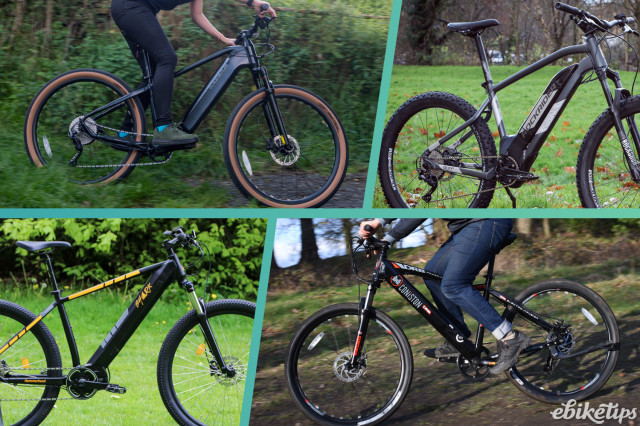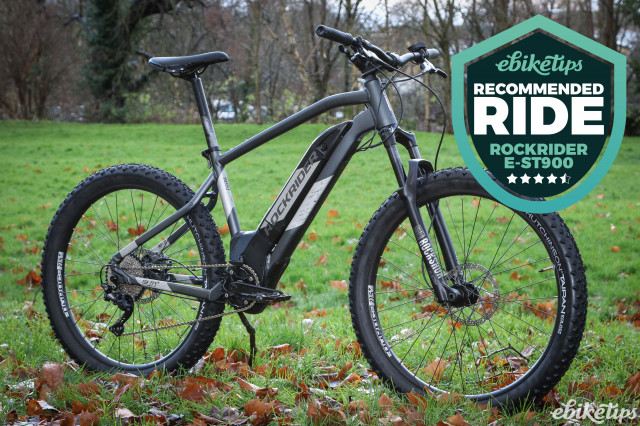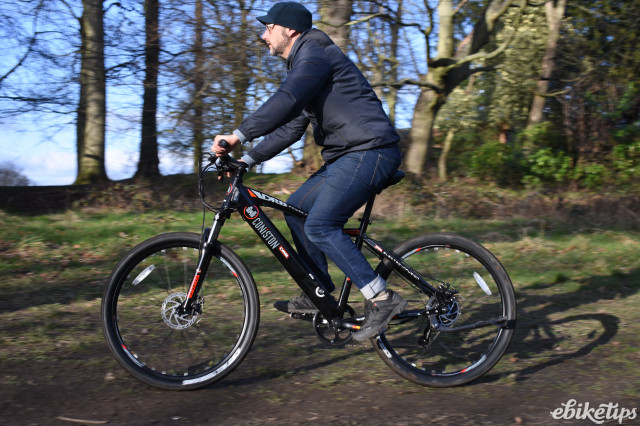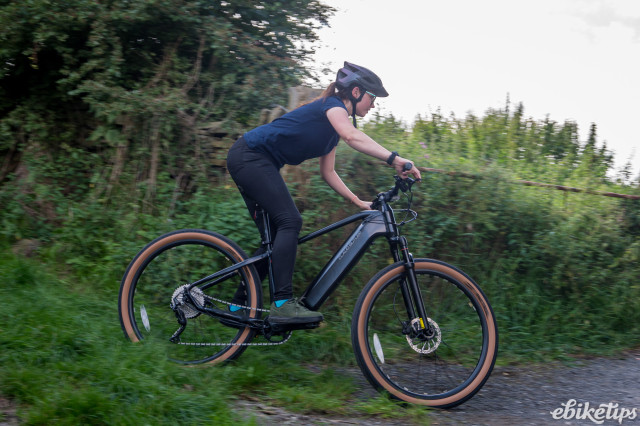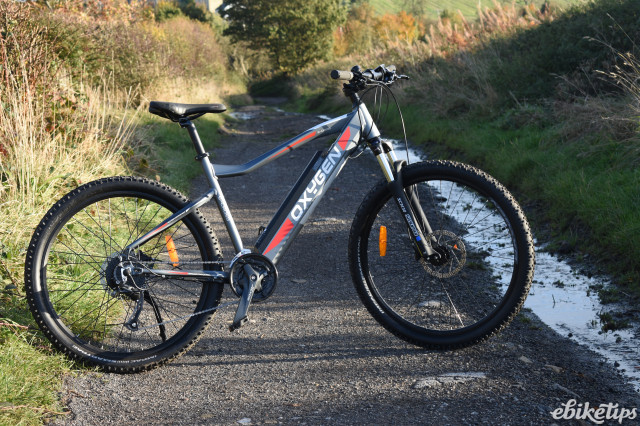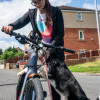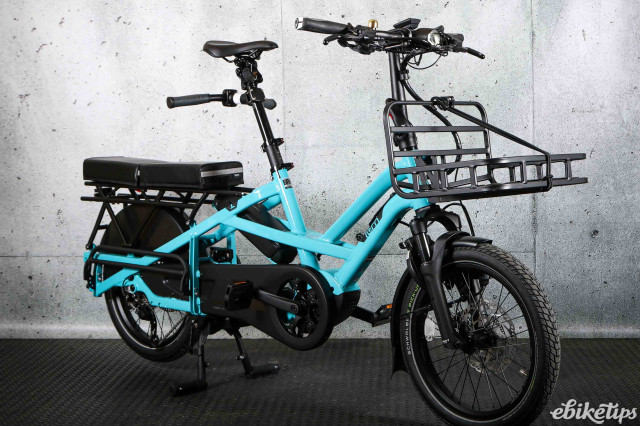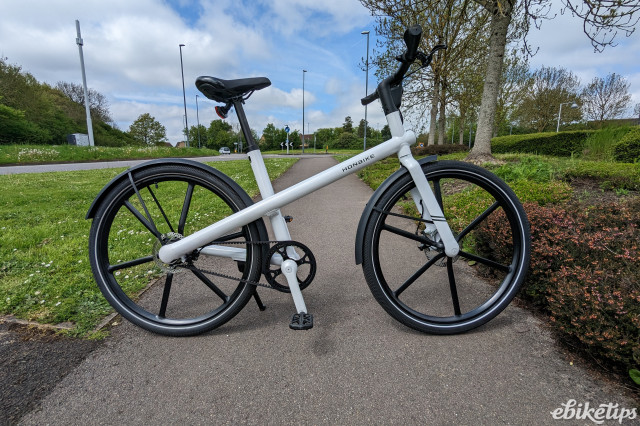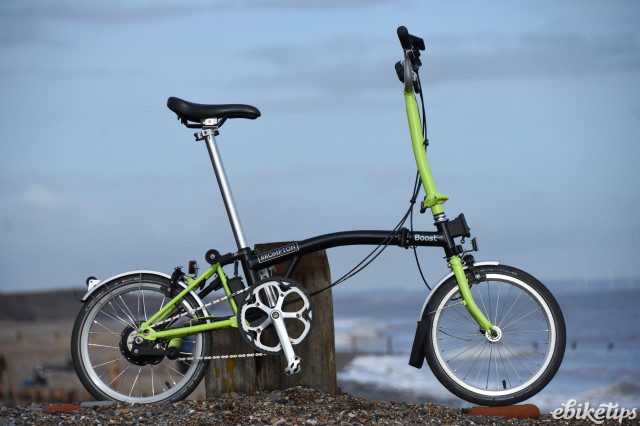Electric mountain bikes come in many forms. From full-suspension rigs to more leisure-focused hardtails, there's something to suit all levels of off-road pursuit. They also make excellent commuter bikes, with sturdy frames, wide tyres and suspension to soften the blow of potholes. At under £2,000 it's unlikely you'll find an eMTB that's ready to hit the trails hard, so e-hardtails are pretty much the order of the day.
We're using the term 'mountain bike' quite liberally in this guide, but essentially if we were afraid to take it off road, we wouldn't give it that label. You're not going to find full-suspension enduro beasts at this price point. Instead, you'll more likely see leisure oriented electric hardtails that would be more at home on bridleways and towpaths than at Dyfi Bike Park. If you want something a bit more capable, read our guide to the best electric mountain bikes for context.
Best electric mountain bikes under £2,000
- Best overall: Decathlon Rockrider E-ST900 | Buy for £1,699 from Decathlon
- Best under £1,500: Dallingridge Coniston | Buy for £1,209 from Pedal and Ride
- Best hub motor: Claud Butler Wrath 2.0 | Buy for £1,899 from Decathlon
- Best of the rest
- FAQs
- How we review e-bikes
Best overall: Decathlon Rockrider E-ST900 - £1,999
A rarity at this price point, the Decathlon Rockrider E-ST 520 features a BROSE T mid-drive motor. This particular one isn’t short on torque either, with up to 70Nm on offer. This is paired with a 500Wh battery, which Decathlon estimates will provide up to three hours of ‘sporty’ riding.
The Rockrider offers a playful frame geometry, a 120mm front RockShox Judy fork and 27.5” wheels, so it’s not for the hardcore riders, but it'll be more capable than many hub-powered bikes also listed.
For more detail, read our review of the Decathlon Rockrider E-ST900.
Best under £1,500: Dallingridge Coniston - £1,349
Like the rest of the Dallingridge range, the Coniston offers a sensible spec for the money. It uses a rear hub motor, which is cadence sensing only. Nevertheless, our reviewer Richard found that it was pretty sensitive and kicked in quickly once he started pedalling. It comes with seven gears, controlled by a twist grip shifter on the handlebars, and mechanical disc brakes.
Three power assist levels are included, although we found that level three was the best for most types of riding. (Levels one and two aren’t underpowered, they’re just better for slow speed negotiating, like in a city centre for example.) The Coniston is ideal for those who want a bike capable of gentle trails and off-road, like canal towpaths or fire roads.
For more detail, read our review of the Dallingridge Coniston.
Best hub motor: Claud Butler Wrath 2.0 - £1,899
The Claud Butler Wrath saw the historic British brand make its mark in the leisure e-MTB market. The 2.0 is the slightly more expensive of the range, with the 1.0 costing £1,649. We think if you can justify the extra cash, the difference in battery size and motor is worth it.
It’s another hub powered bike, this time with a Bafang unit and a battery offering an estimated 40 miles of range. It’s ideal for towpaths and light off-road riding, but beware the sizing. There are two sizes available, medium and large – so if you’re short or really tall, check the fit before you buy. The 2025 version comes with Shimano's 10-speed Cues groupset, too. So it's evidently a bike that Claud Butler is keen on updating year-on-year.
For more detail, read our review of the Claud Butler Wrath 2.0.
Best of the rest
Oxygen S-Cross MTB MKII - from £1,699
The S-Cross MTB MKII is a leisure electric mountain bike from Yorkshire brand, Oxygen. It uses a rear hub motor from Shengyi and a decently large capacity 576Wh battery, which offered our reviewer, Richard, a projected range of about 44 miles.
Richard found the Oxygen a very nice bike to ride - pretty fast and sporty, even with the motor power turned off altogether. The Shimano hydraulic disc braking was excellent and the Altus gears responsive and crisp. "On my longer hilly rides over Pennine tracks and trails it never failed to tackle anything put in front of it, even on muddy and grassy climbs with challenging gradients – even if it wasn’t the fastest up them,” he said.
It’s not the cheapest on this list, but if it’s too much of a stretch you can choose a smaller battery option. However, the Shimano hydraulic disc brakes seem like a decent value proposition at this price point.
For more detail, read our review of the Oxygen S-Cross MTB MKII.
Hammerhead Shark - £2,300, but currently discounted
At full price, the Hammerhead Shark is slightly above our budget of £2,000. But, at the time of review last year it was sub-£2k and it's currently on offer for £1,499 which brings it well under our price ceiling.
The reason it's normally more expensive is because it comes with a mid-drive motor - the Bafang M420. The review bike Ian had came with Suntour XCM 100mm forks, but you can choose 160mm RockShox 35 Gold RL forks if you need that extra bit of travel.
It also comes with a Shimano Deore 10-speed drivetrain and MT200 hydraulic disc brakes with 160mm rotors - showing just how 'leisurely' this steed is. Overall it's decent value for money - even more so when it's on offer.
For more detail, read our review of the Hammerhead Shark.
FAQs
What is the best electric mountain bike under £2,000?
It’s hard to say which bike is the best as it will depend entirely on how you plan on riding it. By this we mean are you going to be sticking to canal towpaths and fire roads, or trying something more technical? There may not be many electric mountain bikes to choose from under £2,000, but the ones we’ve highlighted above are good places to start.
Is an electric mountain bike worth it?
Absolutely! Not only are they incredibly fun, but electric mountain bikes can help you tackle trails and rides you may not have thought possible before. As with most things, the bigger your budget, the better the bike you’ll generally get for your money. At £2k and under, they’re essentially entry level electric mountain bikes and likely won’t be suitable for hardcore trail riding. If you think you can stretch your budget a bit or want to see what else is out there, have a read of our main guide to the best electric mountain bikes.
What’s the difference between a hub motor and mid-drive?
Hub motors are pretty capable and cheap these days. If you're looking at the lower end of this price range then that's what you'll get, either in the front hub or (far more likely) the rear. Up over £2,000 you can get a bike specced with a mid motor instead. For mountain biking, this is better for a number of reasons.
The first benefit is weight distribution. A mid-motor eMTB has all the weight in the middle and that means more predictable handling on more technical terrain. If your bike has a rear hub motor and it's a hardtail bike, the motor weight is concentrated at the centre of the wheel, so if you hit a rock you'll be exerting larger forces on the wheel and rear triangle relative to a mid motor design. If it's a full suspension bike then you have more sprung mass with a hub motor, which will negatively affect the suspension response to changes in terrain. The same is true of a front hub motor in a suspension fork, with the added problem that the heavy motor will increase fork flex, meaning steering isn't as precise.
The other, perhaps bigger, reason why mid-motors are preferable on electric mountain bikes is because of how power is applied. Because they are situated at the pedals, they - like you - can exploit your bike’s gears. This tends to mean they apply power better at lower speeds, in lower gears - when you need it most, basically. You can find more detail in our guide, Electric bike motors: everything you need to know.
For all those reasons, if you're looking to do any proper off-road riding over technical terrain, you're better off with a mid motor bike. There's lots of people who might be looking at an eMTB who aren't planning any white-knuckle stuff, and there's plenty of bikes out there that will be fine for light off-roading at prices well south of the £2,000 mark.
It's also worth noting that if you're looking at mountain bikes and the toughest terrain you're going to be pointing them at is towpaths and fire roads, then there's plenty of hybrid bikes that can easily cope, and you may get more for your money going down that route. Read our guide to the best electric hybrid bikes if you think this could apply to you.
What sort of suspension can I expect on an electric mountain bike under £2,000?
All eMTBs will come with a suspension fork of one sort or another. Most of the bikes below £2,000 are hardtail designs. Hardtail bikes have no suspension at the back, and usually have a fairly standard diamond frame. Full suspension bikes will have some sort of linkage to allow the rear wheel to move, and a shock unit to control the suspension. Full suspension adds weight and complexity and price.
What levels of componentry are popular on electric mountain bikes under £2,000?
You'll likely see derailleur gears from Shimano, or SRAM, and disc brakes on mountain bikes under £2,000. Hydraulic brakes (where the brake is actuated by hydraulic fluid in a hose) are generally considered to be better than mechanical brakes (where a cable is used to pull the brake). The suspension fork will probably be made by RockShox or SR Suntour if you're nearer the £2,000 mark, and by Suntour (a lower spec model) or Zoom for lower budget bikes; it may also be branded the same as the bike.
Currently there are three wheel sizes for mountain bikes. 26-inch is the original size and used for most budget bikes, with the newer 27.5-inch and 29-inch sizes more common on higher-end trail bikes. There are also plus-sized systems, which use a wider rim and a bigger tyre. They're good for eMTBs because they give more grip and have a bigger air chamber in the tyre to soak up bumps from rocks and roots.
Explore the complete archive of reviews of electric mountain bikes on ebiketips and also our sister site off-road.cc.
